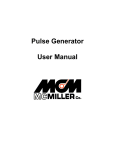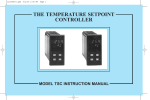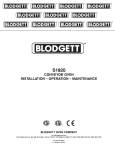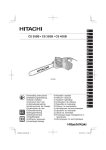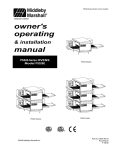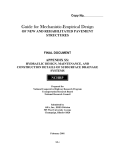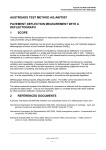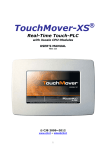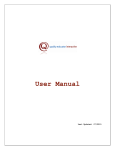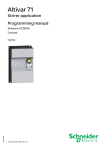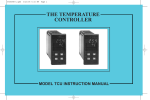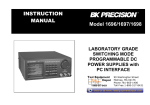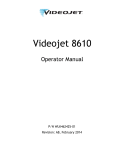Download to view the operation manual ()
Transcript
MODEL CS325B ASPHALT ROLLING THIN FILM OVEN OPERATING INSTRUCTIONS 1998 JAMES COX AND SONS, INC. 1085 Alpine Way P.O. Box 674 Colfax, CA 95713 PAGE Revised February 28, 2002 CONTENTS 2. Model CS325B 3. Important Precautions 4. Getting Started: Electrical and Air Requirements 5. Operating Instructions 6. System Checks: 1) Air Regulator 2) 3) 4) 5) Temperature Control Flow Meter Calibration Air Nozzle Moisture Indicator 7. Control Panel Layout-Front Fig.1 8. Control Panel Layout-Back Fig.2 9. Controller Programming 11. ASTM Spec D 2872-97 19. Parts List 20. Electrical Schematic 60Hz Fig.6 21. Electrical Schematic 50Hz Fig.7 22. Motor Control Settings 50Hz Fig.8 23. Air Schematic Fig.9 24. Flow Meter Calibration Chart 25. Dry Air System Schematic Fig.10 26. Temperature Sensor Modification 27. Troubleshooting 28. F.A.Q. ( Frequently Asked Questions ) 29. Calibration 30. Warranty 1 James Cox & Sons, Inc. 1997 MODEL CS325B ASPHALT ROLLING THIN FILM OVEN The Model CS325B Precision oven is designed for the specific requirements of the Asphalt Rolling Thin Film Tests as specified in State of California Test Method 346-E, AASHO T-240 and ASTM D2872. Repeatability of the aforementioned test is directly related to the accuracy with which the oven temperature can be maintained to the specified standard temperature of 325° F (163° C), and the reproducibility of the thermal rise-time of the system within the time period allocated from load time to assumed equilibrium of the system. The CS325B has been designed to optimize the precision of performance with regard to maintenance of setpoint while attaining high-speed recovery from thermal disturbances caused by reloading. The oven temperature is sampled by a precision sensor exposed to the supervised environment at a location which is representative of the desired specimen location. The thermal mass of the sensor is extremely low, having a thermal/electrical time constant measurable in seconds. The system is a fully stabilized closed loop thermal/electrical feedback control system. The system has fast response, tight control limits and freedom from overshoot. There are no mechanical relays, contactors, commutators, mechanically operated or thermal-pressure magnetic devices utilized. The entire system is fully electronic, noiseless and non-mechanical in nature. There is nothing to wear or fatigue. High speed of response is assured by complete control of a 2000 watt heating element. Thermal conduction and radiation losses are low and virtually all applied power is consumed in replacing losses due to the air vents required for dissipation of expended volatile from the specimens. Every precaution has been taken in the preparation of this publication. Cox & sons assumes no responsibility for errors or omissions. Neither is any liability assumed for damages resulting from use of the information contained herein. 2 IMPORTANT 1. Do not open door with blower or rack-motor on. 2. Disconnect oven power supply at source when working inside the cabinet to avoid electrical shock. 3. Turn sample rack with control button to prevent damage to gear reducer. 4. The air nozzle will cause breakage if the sample containers are not placed firmly against the rack backstop. 3 ELECTRICAL REQUIREMENTS Electrical: Maximum load, 2 KVA. Power factor, 0.90. 2000 Watt heating element. Standard: 208 - 240 VAC, 60 Cycle, single phase. 3 Wire grounded neutral. Optional: 220 VAC, 50 Cycle, single phase. Thermal Protection: Electrical circuits fully protected by temperature switch and fuses in both legs. The thermal protection on the switch is 425° F. The switch allows the heat to shut down at 425° F and turn back on at 375° F repeatedly until the problem is resolved. See page 20, Fig.6, 60Hz or page 21, Fig.7 50Hz for Electrical Schematic. AIR REQUIREMENTS Air System Requirements: a) b) c) d) Air supply to this unit should not exceed 125 PSI Supply dry clean air. See page 25, Fig.10 for example If air supply is contaminated, install an air filter If moisture or oil fumes are present, install a dehydrator 4 OPERATING INSTRUCTIONS Step 1: Push Power Button Push Power Blower and Sample Rack Buttons. Step 2: Set air pressure by using pressure regulator knob. Pull Knob out to release lock. Turn until it reads 50 PSI on pressure gauge. Push knob to re-lock. Set air flow tube by using flow meter control knob, turning counter-clockwise. Bring ball up to the calibrated set point. See page 24. Step 3: Allow oven to come up to temperature and stabilize at 163° C. Oven is now ready to install test samples. Turn blower and sample rack off, leaving power button on. Put bottles in rack, close door and turn on blower and sample rack. Oven will return to 163° C in 10 minutes. The test should be performed following the AASHO T-240 and ASTM D2872 procedures. See page 11 ASTM Specs. NOTE: Your oven temperature controller has been programmed at our facility to perform applicable tests. You should not need to change any controller settings, if you do need to adjust temperature refer to page 9. 5 CONTROL PANEL-SYSTEM CHECKS 1) Air Regulator: Setpoint 50 PSI. 2) Temperature Control: The control is programmed for the required thermal rising time and the 163° C setpoint as required by the rolling thin film test. The only adjustment that may be necessary is a slight change in the temperature setpoint. Refer to page 9, “Controller Programming”, steps 4 & 5 3) Flow Meter Calibration: The air flow rate of 4000ml should be measured at the outlet nozzle by a suitable method. The oven should be at room temperature and correction made to standard conditions of barometric pressure and temperature. This measurement should be checked periodically. See page 24 for chart 4) Air Nozzle: a) Clean with No. 60 twist drill. b) Use the shank end of the drill to prevent enlarging the orifice. 5) Moisture Indicator: a) Contains color-changing blue silica gel; •dry air-blue •moist air-pale pink b) The indicator reactivates itself when dry air flows through it. However, in time it may lose this quality and it would be necessary to replace the silica gel. 6 CONTROL PANEL LAYOUT FRONT Fig. 1 7 CONTROL PANEL LAYOUT BACK Fig. 2 8 CONTROLLER PROGRAMMING Step 1: To enter into program A. Push the PAR button once, this puts you into program A. Step 2: To enter into program 1, 2, or 3. For instance, you want program 2, you press PAR button four times, the control will then flash “CNFP” or “NO” on screen. At this point you need to press the UP button on the controller two times, which puts you into program 2. If you want to program 3, press the UP button three times. Step 3: Programming the 1, 2, or 3. For instance, if programming is needed to program 2; after entering into program 2, press the PAR button once, twice, three times, etc., until required letters appear on the screen. Press the UP or DOWN button to obtain the correct number needed. Press the PAR button repeatedly until “CNFP” or “NO” flashes on the screen. At this point, press the UP or DOWN button to enter in another program and repeat procedure or press PAR button when “CNFP” or “NO” is on screen. When the program is complete, “END” will appear on the screen; the controller will then display “TEMP”. TEMPERATURE ADJUSTMENT Step 4: After the oven has been running and temperature is stabilized on controller, make a comparison to an ASTM thermometer. If there is a difference, you need to enter program 1. After entering program 1, press the PAR button six times. SHFE should appear on the screen. At this time you would press the UP or DOWN button depending on the oven temperature; UP to cool and DOWN to heat. Step 5: To end procedure, press the PAR button until “CNFP” or “NO” appears on the screen. Press PAR once again, “END” will appear and controller will return to normal display. 9 CONTROL PANEL PROGRAM A PROP Proportional Band 0.5 INTT Integral Time 70 DERT Derivative Time 2 (CNFP or NO) ______________________________________________________________________ 1 TYPE Input Sensor Type R385 SCAL Temp. Scale Units °C DEPE 0.0 FLTR Digital Filtering 3 SPAN Input Slope 1.000 SHFT Input Offset ± SPLO Setpoint Lower Limit 50.0 SPHI Setpoint Upper Limit 200.00 SPRP Ramp Rate 25 ____________________________________________________________________ 2 OP CYCT OPAC OPLO OphI OpfL OPDP Access Output Power Cycle Time Control Action 0 Output Lower Upper Limit Range Sensor Fail Power Preset Output Power Dampening On/Off Control Hysteresis Auto Tune Dampening Code 1 REV 65 0 3 ChyS 1.0 tcod 4 _______________________________________________________________________ 3 SP-ENT OP-ENT DEV-RED UDSP-RED CODE Access Code Number 0 PID-ENT TRNF-LOC Enable Auto/Man Transfer LOC TUNE-LOC Enable Auto-tune LOC 10 ASTM SPEC D 2872-97 Standard Test Method for Effect of Heat and Air on a Moving Film of Asphalt ( Rolling Thin-Film Oven Test ) 11 Designation: D 2872 - 97 AMERICAN SOCIETY FOR TESTING AND MATERIALS 1 X Barr Harbor Dr. West Conshohocken, PA 19428 Reprinted from the Annual Book of ASTM Standards. Copyright ASTM Standard Test Method for Effect of Heat and Air on a Moving Film of Asphalt (Rolling Thin-Film Oven Test) 1 This standard is issued under the fixed designation D 2872; the number immediately following the designation indicates the year of original adoption or, in the case of revision, the year of last revision. A number in parentheses indicates the year of last reapproval. A superscript epsilon (E) indicates an editorial change since the last revision or reapproval. Scope 1.1 This test method is intended to measure the effect of heat and air on a moving film of semi-solid asphaltic materials. The effects of this treatment are determined from measurements of the selected properties of the asphalt before and after the test. 1.2 The values stated in inch-pound units are to be regarded as the standard. 1.3 This standard does not purport to address all of the safety concerns, if any associated with its use. It is the responsibility of the user of this standard to establish appropriate safety and health practices and determines the applicability of regulatory limitations prior to use. 2. Referenced Document 2.1 ASTM Standard: D 113 Test Method for Ductility of Bituminous Materials 2 D 2171 Test Method for Viscosity of Asphalt's by Vacuum Capillary Viscometer 2 E I Specification for ASTM Thermometers 3 3. Summary of Test Method 3.1 A moving film of asphaltic material is heated in an oven for 85 min at 325°F (163°C). The effects of heat and air are determined from changes in physical test values as measured before and after the oven treatment. An optional procedure is provided for determining the change in sample mass. 3.2 Precision values for this test method have been developed for viscosity at 140°F (60°C); and ductility at 60° (15.6°C). 4. Significance and Use 4.1 This test method indicates approximate change in properties of asphalt during conventional hot-mixing at about 302°F (150°C) as indicated by viscosity and other rheological measurements. It yields a residue, which approximates the asphalt condition as incorporated in the pavement. If the mixing temperature differs appreciably from the 302°F (150°C) level, more or less effect on properties will occur. This test method also can be used to determine mass change, which is a measure of asphalt volatility. 5. Apparatus 4 5.1 Oven—This shall be a double-walled electrically heated convection-type oven. Its inside dimensions shall be 15 in. (381 mm) high, 19 in. (483 mm) wide, and 17-1/2 ± 1/2 in. (445 ± 13 mm) deep (with the door closed). The door shall contain a symmetrically located window with dimensions of 12 to 13 in. (305 to 330 mm) wide by 8 to 9 in. (203 to 229 mm) high. The window shall contain two sheets of heat-resistant glass separated by an air space. The window should permit an unobstructed view of the interior of the oven. The top of the upper heating element shall be 1 ± 1/8 in. (25 ± 3 mm) below the oven floor. 12 5.1.1 The oven shall be vented at the top and bottom. The bottom vents shall be located symmetrically to supply incoming air around the heating elements. They shall have an open area 2 of 2.31 ± 0.11 in (15.0 ± 0.7 cm 2 ). The top vents shall be symmetrically arranged in the upper part of the oven and have an open area of 1.45 ± 0.07 in 2 (9.3 ± 0.45 cm 2 ). 5.1.2 The oven shall have an air plenum covering the sidewalls and ceiling. The air space shall be 1-1/2 in. (38.1 mm) deep from the walls and ceiling. At a midpoint in the width of the oven, and 6 in. (152.4 mm) from the face of the circular metal carriage to its axis, a squirrel cage-type fan 5-1/4 in. (133 mm) OD by 2-7/8 in. (73 mm) wide shall be turned at 1725 rpm by an externally mounted motor. The squirrel cage fan shall be set so that the fan turns in an opposite direction to its vanes. The airflow characteristics of the fan-plenum system shall be suction from the floor of the oven through the wall plenums and exhaust of the air through the fan. Figures 3 and 4 show details of this plenum system. 5.1.3 The oven shall be equipped with a proportional control thermostat capable of maintaining 325°F (163°C) temperature within ±1.0°F (±0.5.C). The sensing element of the thermostat shall be placed 1 in. (25.4 mm) from the left side and approximately 1-1/2 in. (38.1 mm) from the ceiling of the interior of the plenum-enclosed oven so that the end of the sensing element is at a point approximately 8 in. (203.2 mm) from the rear interior wall of the oven. The thermometer shall be hung or affixed to a mounting in the ceiling which is 2 in. (50.8 mm) from the right side of the oven at a midpoint in the depth of the oven. The thermometer shall hang down into the oven so that the bulb of the thermometer is within 1 in. of an imaginary line level with the shaft of the circular metal carriage. The heating controls shall be capable of bringing the fully loaded oven back to the test temperature within a 10-min period after insertion of the samples in a preheated oven. 5.1.4 The oven shall be provided within a 12-in. (304.8mm) diameter, vertical circular carriage (see Fig. 4 for details). This carriage shall be provided with suitable openings and clips for firmly holding eight glass containers in a horizontal position (see Fig 5). The vertical carriage shall be mechanically driven through a 3/4-in. (19-mm) diameter shaft at a speed of 15 ± 0.2 r/min. 5.1.5 The oven shall be equipped with an air jet positioned to blow heated air into each bottle at its lowest point of travel. The air jet shall have an outlet orifice 0.04 in. (1.016 mm) in diameter (No. 60 drill) connected to a 25 (7.6-m) length of 5/16 in. (8-mm) outside diameter refrigeration copper tubing. This tubing shall be coiled to lie flat on the bottom of the oven and lead to a source of fresh, dried, dust-free regulated air. 5.2 Flowmeter—The flowmeter may be any suitable type capable of accurately measuring the airflow at a rate of 4000 mL/min. The flowmeter shall be located downstream of all regulating devices and upstream of the copper coil. The flowmeter shall be positioned so it is maintained at approximately room temperature. The airflow shall be calibrated periodically using a wet-test meter or other displacement method. This calibration shall be based on airflow exiting the air jet and shall be conducted with the oven off and at room temperature. 1This test method is under the jurisdiction of ASTM Committee D-4 on Road and Paving Materials and is the direct responsibility of Subcommittee D04.46 on Durability and Distillation Tests. Current edition approved April 10, 1997. Published April 1998. Originally published as D 2872 - 70. Last previous edition D 2872 - 88 ( 1995)ei. 2 Annual Book of ASTM Standards, Vol. 04.03. 3 Annual Book of ASTM Standards, Vol. 14.03. 4 Complete equipment may be obtained from James Cox and Sons Inc., P.O. Box 674, Colfax, CA 95713. 13 D 2872 FIG. 3 Schematic of Air Flow Front View Note 1—Activated silica gel treated with an indicator is a satisfactory desiccant for the dried air. 5.3 Thermometer—This shall be an ASTM Loss on Heat Thermometer conforming to the requirements for Thermometer 13C as prescribed in Specification E 1. This thermometer shall be used to make all temperature measurements required by this test method. 5.4 Container—The container in which the sample is to be tested shall be of heat-resistant glass conforming to the dimensions shown in Fig 5. 5.5 Cooling Rack—A wire or sheet metal rack constructed of stainless steel or aluminum, which allows the sample containers to cool in a horizontal position, with each container in the same horizontal plane. The rack shall be constructed in a way that allows air to flow freely around each container with at least 1 in. (2.5 cm) clearance between containers and at least 1 in. (2.5 cm) clearance between the containers and any solid surface. 14 D 2872 Fig. 4 Circular Carriage FRONT VIEW MATERIAL— PYREX BRANO TUBING STANOARO WALL 64 MM O.D. WALL THICKNE55 24MM ± 3 MM SIDE VIEW 6. Preparation of Oven 6.1 Position the air outlet orifice so that it is 1/4 in. (6.35 mm) from the opening of the glass container. The orifice shall also be so positioned that the jet blows horizontally into the central arc of the opening of the circling glass container. 6.2 Position the thermometer specified in 5.3 so that the end of the bulb of the thermometer is within 1 in. (25.4 mm) of an imaginary line level with the center of the shaft holding the revolving carriage. 6.3 Level the oven so that the horizontal axes of the glass containers when in position in the carriage are level. 6.4 Preheat the oven for a minimum of 16 h prior to testing with the control thermostat adjusted to the setting that will be used during the test. This setting shall be selected such that when the oven is fully loaded and the air is on, the oven will equilibrate at 325 ± 1°F (163 ± 0.5.C), as indicated by the test thermometer. NOTE 2—Because the presence of sample containers affects the temperature distribution in the oven, containers must be present in the oven when the thermostat seeing is determined. The use of empty containers is acceptable for this purpose. SAMPLE BOTTLE FIG. 5 Sample Bottle 15 D 2872 Test Method Single-operator precision: Viscosity at 140°F (60°C) Ductility at 60°F (15.6°C)A Multilaboratory precision: Viscosi1y at 140°F (60°C) Ductility at 60°F (15.6°C)^ Standard Deviation (1s) ... 3 rrn .. 6 an Acceptable Range of Two Results (d2s) Coefficient of Variation (Percent of mean) (1s %) ... Acceptable Range of Two Results (percent of mean) (d2s %) 2.3 9 un … ... 16 cm ... 6.5 ... 4.2 11.9 .. . A This is based on the analysis of data resulting from tests by 16 laboratories on two asphalt's ranging born 13 to 30 cm. 7. Procedure 7.1 The sample as received shall be free of water. Heat the sample in its container with a loosely fitted cover in an oven not to exceed 302°F (150°C) for the minimum time necessary to ensure that the sample is completely fluid. Manually stir the sample but avoid incorporating air bubbles. 7.2 Pour 35 ± 0.5 g of the sample into each of the required glass containers, providing sufficient material for characterizing tests which are to be run on the residue. 7.3 Immediately after pouring the sample into a glass container, turn the container to a horizontal position, without rotating or twisting. Place the container in a clean cooling rack, which is maintained in a draft free, room temperature location, away from ovens or other sources of heat. NOTE 3—For maximum precision in determining mass change, the cooling rack should be in a location that is the same temperature and humidity as the balance used for measuring the mass of the containers. 7.3.1 Allow the glass sample containers to cool in the cooling rack for a minimum of 60 min, and a maximum of 180 min. 7.3.2 When mass change is being determined, use two separate containers for this determination. After cooling, separately place each of these containers vertically on an analytical balance, and determine its mass to the nearest 0.001 g. 7.4 With the oven at operating temperature and the airflow set at 4000 ± 200 mL/min, arrange the containers holding the asphalt in the carriage so that the carriage is balanced. Fill any unused spaces in the carriage with empty containers. Close the door and rotate the carriage assembly at a rate of 15 ± 0.2 r/min. Maintain the samples in the oven and the air flowing and the carriage rotating for 85 min. The test temperature 325 ± 1°F (163 ± 0.5.C) shall be reached within the first 10 min; otherwise, discontinue the test. 7.5 At the conclusion of the testing period, remove any samples for mass change determination and place them horizontally in the cooling rack. Then, remove each remaining glass sample container, one at a time, and transfer its contents to a collection container having a capacity at least 30 % greater than the total expected volume of residue. This transfer shall be accomplished by first pouring out any residue that will flow freely from the glass sample container and then scraping out as much of the remaining residue as practical. While the residue is being removed from each sample container, the oven door shall remain closed, with the heater power on, the air 16 on, and the remaining samples rotating in the carriage. The final container shall be removed from the oven within 5 min of removal of the initial container. NOTE 4—Any scraping tool or technique may be used, as long as an average of 90 % or more of the residue is removed from the sample containers. It has been determined that circumferential scraping tends to be more effective than lengthwise scraping 7.6 After removing the residue from each of the glass containers, gently stir the collection container to homogenize the residue without introducing air into it. Test the residue within 72 h of performing the RTFO test. 7.7 If the mass change is being determined, allow the designated residue sample containers to cool on the cooling rack for a minimum of 60 min and a maximum of 180 min. After cooling, place each container vertically on an analytical balance and determine its mass to the nearest 0.001 g. Discard the residue from mass change determination, and do not use it for other tests. NOTE 5—To improve mass change precision, the containers used for determining mass change should be handled with clean gloves or tongs, and transfer to the balance should be done with tongs, to prevent temperature changes which could distort the mass measurement. 8. Report 8.1 Report the results from RTFO test in terms of the physical changes in the asphalt brought about by this method. These values are obtained by performing appropriate ASTM tests on the asphalt before and after the moving film oven cycle. 8.2 When determined, report the average mass change of the material in the two containers as a mass percent of the original material. Report this calculated result to the nearest 0.001 %. A mass loss shall be reported as a negative number while a mass gain shall be reported as a positive number. Note 6—This test can result in either a mass loss or a mass gain. During the test, volatile components evaporate, causing a decrease in mass, while oxygen reacts with the sample, causing an increase in mass. The combined effect determines whether the sample has an overall mass gain or an overall mass loss Samples with a very low percentage of volatile components usually will exhibit a mass gain, while samples with a high percentage of volatile components usually will exhibit a mass loss. 17 9. Precision and Bias 9.1 Criteria for judging the acceptability of the viscosity at l 40°F (60° C) and the ductility at 60°F (15.6°C) test results on the residue after heating are given in Table 1. The values given in Column 2 are the standard deviations that have been found to be appropriate for the materials and conditions of test described in Column 1. The values given in Column 3 are the limits that should not be exceeded by the difference between the results of two properly conducted tests. The values given in Column 4 are the coef6~cients of variation that have been found to be appropriate for the materials and conditions of test described in Column 1. The values given in Column 5 are the limits that should not be exceeded by the difference between the results of two properly conducted tests expressed as a percent of their mean. 9.2 The precision of the loss of mass determinations has not been determined. 10. Keywords 10.1 aging; asphalt cement; rolling thin-film oven test (RTFOT) The American Society for Testing and Materials takes no position respecting the validity of any patent rights asserted in connection with any item mentioned in this with any standard. Users of this standard are expressly advised that determination of the validity of any such patent rights, and the risk of infringement of such rights, are entirely their own responsibility. This standard is subject to revision at any time by the responsible technical committee and must be reviewed every five years and it not revised either reapproved or withdrawn. Your comments are invited either for revision of this standard or for additional standards and should be addressed to ASTM Headquarters. Your comments will receive careful consideration at a meeting of the responsible technical committee, which you may attend. It you feel that your comments have not received a fair hearing you should make your views known to the ASTM Committee on Standards, 100 Barr Harbor Drive, West Conshohocken, PA 19428 18 CS325B RTF OVEN PARTS LIST Item # Item Description 325:01B 325:01A 325:02 325:03 325:04 325:06 325:07 325:08 set) 325:09B 325:09A 325:10 325:11 325:12 325:13 325:14 325:15 325:16 325:17 325:20 325:21 325:26 325:27 325:28 Bodine Rack Motor 60cycle Dayton Rack Motor 50cycle Heating Coil Power Switch Sample Rack Switch Blower Switch Sample Rack Assembly Sample Rack Spindle Bushing-(1 Blower Motor 60cycle Blower Motor 50cycle Blower Motor Flexible Coupling Blower Spindle Housing Blower Shaft-3/8 Diameter Blower Bushings Squirrel Cage Top Motor Mount Air Heating Coil Flow Meter Adjustment Valve Moisture Indicator Air Regulator Sample Bottles-Clear Sample Bottles-Frosted Air Nozzle Item # Item Description 325:29 325:30 325:31 325:32 325:33 325:33B inch) 325:35 325:36 325:37 325:38 325:39 325:40 325:41 325:42 325:44 325:51A 325:51B 325:53 325:54 325:55 325:56 325:57 325:58 Rack Shaft Rack Fingers-(set of 8) Transformer Rack Spindle Housing Silicon Gasket for Door (per inch) Silicon Gasket for Door Glass (per Plastic Handle for Door Handle Assembly (include. #35) Silica Gel-1LB can Pyrex Plate Thermometer Chain Transite Plate Latch-Set (inside) DC Motor Control RTD Sensor RTD Sensor Controller-Series B lst Micro Switch Cvr Jar Tongs Drive Gear 25B15 (small 60Hz) Drive Gear 25B25 (medium 50Hz) Drive Gear 25B30 (large 60Hz ) 19 ELECTRICAL SCHEMATIC 60 Hz ASPHALT OVEN Fig. 6 20 ELECTRICAL SCHEMATIC 50 Hz ASPHALT OVEN Fig. 7 21 MOTOR CONTROL SETTINGS & LOCATION 50 Hz Fig. 8 22 AIR SCHEMATIC Fig. 9 23 FLOW METER CALIBRATION OVEN MODEL# _____________ SERIAL# ___________________ Date of Calibration ____________ ADJUST CENTER OF BALL TO ___________ ON FLOW METER THIS WILL EQUAL A CALIBRATED FLOW FOR 4000 ML. 24 DRY AIR SYSTEM AS NEEDED - CAN BE SUPPLIED BY CUSTOMER OR PURCAHSED FROM MANUFACTURE FOR PRICE CONTACT SALES Fig. 10 DRY AIR SYSTEM PARTS LIST ORDER #-PART 325:DA1 325:DA2 325:DA3 325:DA4 Condensate Seperator Filter Oil Coalescing Desiccant Dryer 25 CS325 RTF OVEN MODIFICATION The ASTM Specification requires the Control Temperature Sensor be mounted 1 inch (25.44mm) from the left side and approximately 1.5 inches (38.1mm) from the ceiling of the interior plenum. The end of the sensing element should be at a point approximately 8 inches (203.2mm) from the rear interior wall of the oven. The location of this sensor, as required by the ASTM specification, makes it impossible to control the temperature in the 10 minute ramp time allowed without over-shooting the required set point of 163° C (it over-shoots approximately 2° C). The basic problems are the location of the control sensing element and insufficient air flow pass the sensor. ASTM requires the temperature is to be measured at mid point of the oven by a certified thermometer. The control sensor should also be located near the bulb of the thermometer. In the original oven design, prior to the addition of the blower system, the control sensor was placed next to the thermometer in the center of the oven. At that time the oven conformed to the 10 minute ramp specification without over-shoot. The temperature controller we now use is a programmable Microprocessor unit with PID tuning constants, over-shoot suppression, dampening, ramping, etc. Using this state-of-the-art control with various programs, we still have approximately 2° C of over-shoot. We realize this is an ASTM standard test and they require the control sensor at a specific location. We are furnishing the unit with two control sensors. For the most precise control and no over-shoot, we use the one located near the bulb of the thermometer and the ASTM sensor with wiring installed but not connected. We are leaving the choice of which sensor to use up to our customers. If you wish to use the ASTM location sensor, (with over-shoot), disconnect the power from the oven and exchange the wiring at the temperature controller terminal block connector numbers 10, 11, and 12. ASTM sensor color code: Red 10 Red 11 White 12 26 Troubleshooting In Case of apparent malfunction, please check the following points first. 1. Noisy Rack Motor ? Check chain for adjustment, the Sprocket on the Rack may be tight (adjust to .020), or you may have a bad motor. 2. Noisy Blower Motor ? Check Graphite Bushings (they may be worn), Squirrel cage may be out of balance or it needs to be tightened, Improper adjustment, Bad Motor. 3. Rack will not Turn ? Bad Rack Motor, Check fuse, Sprocket is loose on Motor, Bad Rack Switch 4. Power on, but no Heat ? Bad RTD Sensor, Bad connections to heating coils, Check Fuse, Bad Switch, Check for broken wire from RTD to Controller. 5. No Power to Oven ? Check wiring from your service panel to oven, Check Fuses, See Schematic for your Oven. See Page 20 Fig.6 or 21 Fig.7 in your User Manual. 27 F.A.Q. Frequently Asked Questions 1. Power Requirements ? See Page 4 in the User Manual. 2. What is the Max. Air Pressure ? Air supply to this unit should not exceed 125 PSI, See Page 4 in the User Manual. 3. What PSI should I set the Regulator to ? Turn regulator until Pressure Gauge reads 50 PSI, See Page 4, 5 in the User Manual. 4. Has the Flow Meter been Calibrated ? Yes, to 4000ml we calibrate before shipping, See Page 24 in the User Manual. 5. Do we offer On Site Service ? Yes, Please call (530)346-8322 for On Site Service Quotation. 6. Can I Mount a Hood Vent to Oven ? Yes, as long s it doesn't Touch the oven or interfere with the performance of Oven. 7. Witch RTD should I be using ? See Page 26 in the User Manual. 28 CALIBRATION 1. Temperature: Our units are supplied with a digital readout. You need to have an ASTM Loss on Heat Thermometer positioned in the RTF Oven per ASTM D 2872-97. The thermometer must reflect the same temperature as the digital readout. The RTD in the digital readout will have a faster reacting time than the thermometer. Our units are preset at the factory. You may need to make some fine tuning adjustments as humidity, elevation, and room temperatures are factors in proper temperature settings. 2. Flow Meter: We suggest using a Mass Flowmeter for calibration of you flowmeter. You can purchase these units from Omega at (1-800) 826-6342. We use a Certified Mass Flow Meter to calibrate our units prior to shipment. 3. Rack Rotation: Our 60 cycle units are preset from the factory. Our 50 cycle units use a variable DC Speed Control and the Rpm’s of the Rack and Blower Motors require calibration on installation. You can purchase an optical tachometer from the Cole-Parmer Instrument Co. (1-800) 323-4340, catalog no. E-87500-10. 29 WARRANTY James Cox & Sons, Inc. warrants all manufactured products to be free of mechanical and electrical defects in materials and workmanship for a period of one year from the date of acceptance by the purchaser. If the date of acceptance is unduly prolonged, the warranty period wi11 automatically commence thirty (30) days from the date of delivery at the customer's site. James Cox & Sons, Inc. wi11 replace or repair free of charge, but not including transportation costs, installation or any other service charges, components or assemblies that are manufactured by us which our inspection reveals to be defective, provided they are returned to our plant within the warranty period. The warranty extends only to those products that have been assembled and installed according to our instructions or by a qualified service engineer. All standard components are covered under the same warranty. Other non-standard, major items which are not manufactured by us but have been requested by the customer as an addition to a standard unit will carry the remaining portion of the warranties of the original manufacturer. This warranty does not cover normal wear of parts or damage resulting from any of the following: negligent use or misuse of the product, use on improper voltage or current, use contrary to operating instructions, or disassembly, repair or alteration by any person other than an authorized service engineer. The terms of the warranty are revoked if any part or assembly is physically modified in any manner whatsoever by the customer or agency other than James Cox & Sons, Inc. without written permission. Assistance agreements are available for products that require on-site repair. The agreements provide emergency service when deemed necessary by the customer. Tourist-class round trip airline transportation wi11 be charged at cost, along with current daily rates for field service personnel. 30































